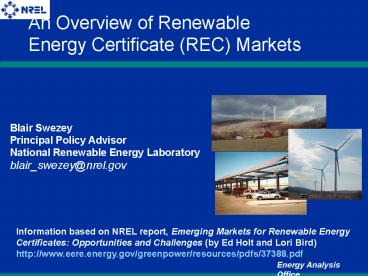Blair Swezey PowerPoint PPT Presentation
1 / 14
Title: Blair Swezey
1
An Overview of Renewable Energy Certificate
(REC) Markets
Blair Swezey Principal Policy Advisor National
Renewable Energy Laboratory blair_swezey_at_nrel.gov
Information based on NREL report, Emerging
Markets for Renewable Energy Certificates
Opportunities and Challenges (by Ed Holt and Lori
Bird) http//www.eere.energy.gov/greenpower/resour
ces/pdfs/37388.pdf
2
Introduction
- What is a REC?
- Represents the attributes of renewable energy
sold separately from the commodity electricity - RECs are also known as green tags, green tickets,
renewable energy credits, tradable renewable
energy certificates (TRCs)
3
Advantages of RECs
- Monetizes the value of the attributes separately
from the commodity electricity - Avoids issues of intermittency and load matching
between the seller and the buyer - Can be sold across geographic boundaries
- May reduce transmission costs
- Allows consumers to support renewables even if
their suppliers dont provide green power options - Small, distributed projects can be aggregated
- Can provide an additional revenue stream for
renewable energy projects
4
REC Market Applications
- Compliance markets
- RPS compliance (most states include RECs)
- Fuel mix disclosure requirements
- Voluntary purchase markets (sold to retail
consumers) - Bundled with electricity
- Unbundled and sold within region
- Unbundled and sold nationally
- Sold in advance of generation
- Emissions markets are emerging
5
RPS and Purchase Obligations
ME 30 by 2000
VT 10 by 2012
MN 10 by 2015
NY 24 by 2013
MT 15 by 2015
RI 16 by 2019
MA 4 new by 2009
WI 2.2 by 2011
CT 10 by 2010
CA 20 by 2017
NJ 6.5 by 2008
IA 105aMW
PA 8 by 2020
NV 15 by 2013
MD 7.5 by 2019
CO 10 by 2015
AZ 1.1 by 2007
16 of 20 states with RPS policies allow or
require the use of RECs
NM 10 by 2011
TX 2880 MW by 2009
HI 20 by 2020
Energy Analysis Office
6
Voluntary Purchase Markets
- RECs are most commonly bundled with electricity
- In competitive markets, primarily
- But some green pricing programs also use RECs
- A number of default suppliers teaming with
marketers and using RECs - Large nonresidential consumers have been most
interested in unbundled RECs
7
Estimated REC Market Size and Value
8
REC Prices in Compliance Markets
- New England (all sources)
- 0.20 to 51.50/MWh
- New Jersey (class I and 2)
- 1.00 to 8.50/MWh
- New Jersey (solar)
- 170 to 275/MWh
- Texas (wind)
- 12.50 to 13.25/MWh
- Factors affecting prices
- Supply adequacy
- New vs. existing resources
- Resource type
- Resource tiers
- Geographic eligibility rules
- Banking and trading rules
- Level of non-compliance penalty
Source Evolution Markets (June 2005)
9
REC Prices In Voluntary Markets
- Factors affecting prices
- Supply and demand
- Competition from compliance markets
- Resource type and location
- New versus existing
- Volume purchased
- New wind (CA, WA, WY)
- 1.00 to 3.00/MWh
- New biomass (ECAR)
- 3.50/MWh
- New solar (CA)
- 30.00/MWh
Source Evolution Markets (June 2005)
10
Key Issues and Challenges
- REC Definition
- What does a REC contain?
- Disaggregation of REC attributes
- REC ownership
- REC tracking and verification systems
- Environmental claims
- Barriers to national REC markets and liquidity
- Emissions market opportunities
- Using RECs to finance new projects
- Communicating the RECs concept
11
REC Ownership Issues
- PURPA contracts
- Most PURPA contracts do not specify RECs
ownership - FERC has ruled that avoided cost contracts do not
automatically convey RECs, but left decision to
states - Most states have not addressed this issue
- Net metering
- Most net metering rules are silent on REC
ownership - State or utility-subsidized systems
- Some state RE funds or utilities have required
transfer of all or some portion of the RECs in
return for providing financial incentives
12
Environmental Claims
- In general, REC buyers should have the right to
claim all the environmental benefits - For emissions subject to cap-and-trade rules, REC
environmental claims may be inaccurate - No environmental claim can be made on capped
emissions unless the renewable generator has been
awarded an emission allowance and then retired
that allowance - For emissions not subject to cap-and-trade, REC
buyers should ensure that the environmental
benefits have not been sold to another party
13
Conclusions
- Compliance markets are currently 3-4x the size of
voluntary markets. - Both markets are continue to grow
- REC prices are generally higher in compliance
markets than in voluntary markets. - Total REC market est. 0.7-0.9 million in 2010
- Higher if more states adopt RPS
14
Conclusions (cont.)
- A truly national REC market does not yet exist
- State and regional tracking systems should be
designed to facilitate national trade - Environmental claims and RECs interaction with
renewable energy and emissions policies are
becoming increasingly important issues

